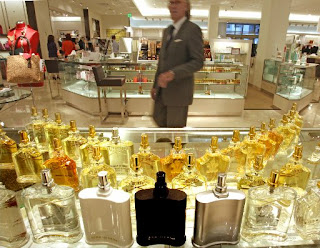I think I might have an olfactory obsession, as this is my second post on fragrance, and I didn't think I'd ever really be writing about this subject. But, rather than telling you how and what to buy, I'm going to tell you all the kinky and creative ways people scented themselves in days gone by. Some methods are quite romantic, others, well, let's just say you'll never look at bacon fat the same way again.
 |
A Tomb painting depicting maids with perfumed cones
atop their wigs. Also popular was the Blue Lotus, but
it was prizes for its narcotic properties rather than
it's perfume alone. |
Neanderthals were known to adorn themselves with flowers to surround themselves with pleasant aromas, but our first ingenious deodorizing diatribe takes us to Ancient Egypt. To combat the arid environment, the Egyptians (men and women a like) shaved themselves from head to toe. For formal ceremonies, both sexes donned ornamental wigs (thus negating the effects of the previously mentioned full body wax) and if they were feeling frisky, false beards. To scent the air around them, Egyptians donned scented cones that sat on top of their wigs. The cones were made of solid animal fat (tallow) fragranced with myrrh and would melt in the desert heat. I'm not sure if this was also some sort of moisturizing treatment or round-about sunscreen protection, but...you know, when in Rome.
 |
Gloves dating to 1603 from the Victoria and Albert Museum.
Trimmed with silver lace, pearls and spangles, scenting
them was gilding the Lily. |
Zooming forward in time we find ourselves in the Renaissance, when, despite being condemned by the clergy (no doubt because of it's association with prostitution and an all around good time), the perfume trade flourished during the Renaissance, so much so that Perfumers developed their own guild. During this period, it was thought that the putrid scents which filled the air from plague, pollution, and general illness also carried contagious disease. As a result, personal accessories began to be designed with compartments to house solid perfumes that would cancel out the foul smells and protect against infection. Doctors walking sticks were made with decorative heads or handles that emitted a fragrance through perforated metal which masked the odors found in slums, hospitals, and mortuaries. A solid perfume scented with herbs was contained within the hollow handle.
 |
Gold, enamel and pearl pomander circa 1620-1640.
Victoria and Albert Museum. |
In the 16th Century, the Marquis do Frangipani was the first to perfume kidskin gloves as other Nobles of Venice and Florence adorned garments and gloves with spherical scented buttons designed to be filled with a fragrant potpourri or solid perfume; its scent emitted though a filigree fretwork of silver. Also popular during the Renaissance, and well beyond for that matter, was the Pomander. A spherical charm worn suspended on a chain from the waist, when unlocked it opens into wedged segments like an orange, with each wedge compartment housing a different scented solid perfume. As a note, while marvelously long-lasting, solid perfumes were historically made from Ambergris; a wax-like substance coveted by the cosmetic industry used not only for perfume but also pomades, powders, and cough drops. The fact that it is derived from Whale vomit or feces (either would do) was gleefully overlooked by the buying public. We of course have synthetics for today's market.
 |
A partial gilt silver pomander dating to 1350 from the Victoria
and Albert Museum. A pin screw holds the hinged segments
together. |
 |
This may have been a love token, which a woman would wear
hanging from a chain at her waist.
The segments refer to the Judgement of Paris,
when he had to decide which of the goddesses Juno, Venus and Minerva
was the most beautiful. Paris chose Venus, here given the words:
"Venus is the loveliest, her claim is clearly just". |
 |
A 1778 painting of Marie Antoinette in a riding costume
with her scented gloves in hand. Antoine Vestier.
Private Collection. |
Galloping forward another 200 years, we land in pre-revolutionary France in the Court of Louis XVI and his number one schnitzel, Marie Antoinette. Contrary to our notions about the French and their bathing habits, Marie, an Austrian by birth, reveled in her beauty regime and bathed daily. Her baths were scented with floating sachets filled with blanched almonds, pine nuts, linseed, lily, and herbs. Other sachets included bran, used as an exfoliant. She scented her water with essence of Lavender and Lemon, and also used these oils to purify the air in her apartment at Versailles. Marie adored her cosmetics and creams, and adorned herself with custom curated fragrances by court perfumer Jean-Louis Fargeon containing rose, violet, jonquil, tuberose, musk, and amber. Fargeon also provided her with scented kidskin riding gloves treated with almond oil, white wax and eau de rose. They were laid on a fresh bed of roses to dry after treatments, and kept her hands moisturized and smelling, well, like a bed of roses. She was known to wear these when not riding as well. Scented gloves and fans were the rage at court, not just because Marie wore them, but because of their practical use in warding of the remnants of whiffy Frenchmen in drafty palace halls.
- Ian

















































